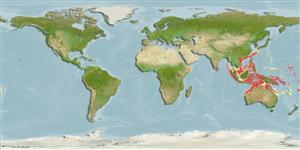>
Perciformes/Serranoidei (Groupers) >
Epinephelidae (Groupers)
Etymology: Epinephelus: Greek, epinephelos = cloudy (Ref. 45335); kupangensis: Name from Latin suffix '-ensis', denoting place or locality, is appended to the locality of Kupang, Indonesia, the center of the Timor Sea fishery that provided the first author with the holotype and several paratypes..
Environment: milieu / climate zone / depth range / distribution range
Écologie
marin récifal; profondeur 50 - 300 m (Ref. 111063). Tropical
Indo-West Pacific: Indonesia (Timor Sea), Timor-Leste, Philippines, Taiwan, and Fiji.
Taille / Poids / Âge
Maturity: Lm ? range ? - ? cm
Max length : 39.1 cm SL mâle / non sexé; (Ref. 111063)
Description synthétique
Morphologie | Morphométrie
Épines dorsales (Total): 11; Rayons mous dorsaux (Total): 15-17; Épines anales 3; Rayons mous anaux: 8. This species is distinguished from its Indo-Pacific congeners by having the following characters: lateral line scales 46-49 (vs. at least 51 in all species except E. areolatus, E.
bilobatus, E. bleekeri, E. bontoides, E. chlorostigma, E. faveatus, E. howlandi, E. longispinis, E. macrospilos, E. maculatus, E. merra, E. miliaris, E. polyphekadion, E. quoyanus, E. timorensis, E. trimaculatus), round caudal fin (vs. emarginate to truncate caudal fin in E. areolatus, E. bleekeri, E. chlorostigma, E. geoffroyi, E. timorensis), no distinct spots over most of head and body (vs. numerous distinct spots - not dots - over most of head and body in E. bilobatus, E. bontoides, E. faveatus, E. howlandi, E. longispinis, E. macrospilos, E. maculatus, E. merra, E. miliaris, E. polyphekadion, E. quoyanus, E. trimaculatus) (Ref. 111063).
This fish is part of a large, deep-water drop line fishery, which focuses its efforts on banks and promontories of shelf habitat in depths of up to 350 m (Ref. 111063).
Life cycle and mating behavior
Maturité | Reproduction | Frai | Œufs | Fécondité | Larves
Tucker, S.J., E.M. Kurniasih and M.T. Craig, 2016. A new species of grouper (Epinephelus; Epinephelidae) from the Indo-Pacific. Copeia 104(3):658-662. (Ref. 111063)
Statut dans la liste rouge de l'IUCN (Ref. 130435)
Menace pour l'homme
Harmless
Utilisations par l'homme
Plus d'informations
PaysZones FAOÉcosystèmesOccurrencesIntroductionsStocksÉcologieRégime alimentaireÉléments du régime alimentaireConsommation alimentaireRation
Noms communsSynonymesMétabolismePrédateursÉcotoxicologieReproductionMaturitéFraiRassemblement de ponteFéconditéŒufsDéveloppement de l'œuf
Taille/ÂgeCroissanceLongueur-poidsLongueur-longueurFréquences de longueursMorphométrieMorphologieLarvesDynamique des populations larvairesRecrutementAbondanceBRUVS
RéférencesAquacultureProfil d'aquacultureSouchesGénétiqueElectrophoresesHéritabilitéPathologiesTraitementNutrientsMass conversion
CollaborateursImagesStamps, Coins Misc.SonsCiguateraVitesseType de nageSurface branchialeOtolithesCerveauxVision
Outils
Articles particuliers
Télécharger en XML
Sources Internet
Estimates based on models
Phylogenetic diversity index (Ref.
82804): PD
50 = 0.5000 [Uniqueness, from 0.5 = low to 2.0 = high].
Bayesian length-weight: a=0.01175 (0.00571 - 0.02419), b=3.04 (2.88 - 3.20), in cm total length, based on LWR estimates for this Genus-body shape (Ref.
93245).
Niveau trophique (Ref.
69278): 3.8 ±0.5 se; based on size and trophs of closest relatives
Résilience (Ref.
120179): Milieu, temps minimum de doublement de population : 1,4 à 4,4 années (Preliminary K or Fecundity.).
Fishing Vulnerability (Ref.
59153): Moderate vulnerability (38 of 100).
